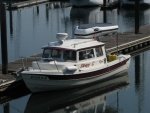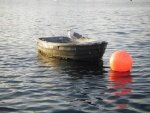journey on
New member
I just ran across this topic on the Hull Truth (a general boat blog,) and I thought I'd share it with this site. I've seen this topic discussed on the C-Brats and. I've often wondered what I'd do if the darn hydraulic cylinder started leaking on Journey On. Well, I now know. Hope it helps someone else.
Quote from the Hull Truth:
First: repairing the leak.
"My SeaStar steering cylinder developed a leak last week after 6 years. Being out of warranty I decided I would replace the seals. I priced the seal kits and was a little shocked at the price. I decided I would tackle this myself. I fabricated a spanner wrench to disassemble the cylinder. Once I had it apart I took the end glands to the hydraulic shop I use for heavy equipment service. The gentleman behind the counter took the old seals out and replaced them with new ones in about two minutes. I noticed the SeaStar seals were much more flimsy than the one the hydraulic shop installed. I reassembled the cylinder and put it back on the boat, bled the system and everything seamed to work perfectly. Did not see any leaks and steering felt as smooth as before. I did the entire replacement for $28. Just throwing this out there to try and save you guys a few bucks.
Next, bleeding the cylinder.
Boatdave: I bled it by myself it is really simple. I bought a fitting that screwed into the fill hole at the steering wheel and connected it to a piece of hose about 36'' long and then into a funnel. I then put about a 15'' hose onto each of the bleeder nipples. I ziptied the funnel to the rail over my windshield and filled it up to the top with fluid. I went to the engine and opened one of the bleeder valves and turned the wheel in one direction until I got an even air free flow of fluid out the nipple and into small bucket. I closed that bleeder valve and did the same with the other side. The key is to not let the funnel and hose become empty or you will get air into the system again. Once you get fluid out with no air spurting then close the valve. The last thing I did was to turn the wheel in one direction until it was tight and hold for 3 seconds. You should sea a bubble or two of remaining air flow up the hose towards the funnel. Repeat by turning the wheel different directions to full turn and it will remove any remaining air. Not sure if this is how the dealers do it but this is how I did it and it worked great.
Finally, a reference to youtube. I haven't found this video.
Yes, based on what I have seen on youtube and what you have stated, I will give it a try."
Boris
Quote from the Hull Truth:
First: repairing the leak.
"My SeaStar steering cylinder developed a leak last week after 6 years. Being out of warranty I decided I would replace the seals. I priced the seal kits and was a little shocked at the price. I decided I would tackle this myself. I fabricated a spanner wrench to disassemble the cylinder. Once I had it apart I took the end glands to the hydraulic shop I use for heavy equipment service. The gentleman behind the counter took the old seals out and replaced them with new ones in about two minutes. I noticed the SeaStar seals were much more flimsy than the one the hydraulic shop installed. I reassembled the cylinder and put it back on the boat, bled the system and everything seamed to work perfectly. Did not see any leaks and steering felt as smooth as before. I did the entire replacement for $28. Just throwing this out there to try and save you guys a few bucks.
Next, bleeding the cylinder.
Boatdave: I bled it by myself it is really simple. I bought a fitting that screwed into the fill hole at the steering wheel and connected it to a piece of hose about 36'' long and then into a funnel. I then put about a 15'' hose onto each of the bleeder nipples. I ziptied the funnel to the rail over my windshield and filled it up to the top with fluid. I went to the engine and opened one of the bleeder valves and turned the wheel in one direction until I got an even air free flow of fluid out the nipple and into small bucket. I closed that bleeder valve and did the same with the other side. The key is to not let the funnel and hose become empty or you will get air into the system again. Once you get fluid out with no air spurting then close the valve. The last thing I did was to turn the wheel in one direction until it was tight and hold for 3 seconds. You should sea a bubble or two of remaining air flow up the hose towards the funnel. Repeat by turning the wheel different directions to full turn and it will remove any remaining air. Not sure if this is how the dealers do it but this is how I did it and it worked great.
Finally, a reference to youtube. I haven't found this video.
Yes, based on what I have seen on youtube and what you have stated, I will give it a try."
Boris



